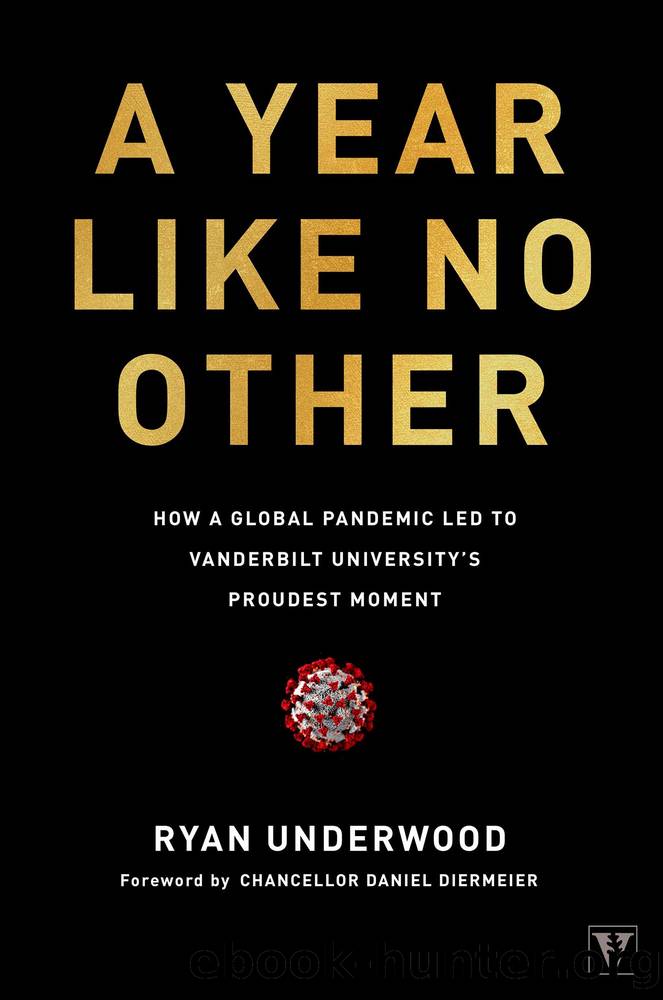A Year Like No Other: How a Global Pandemic Led to Vanderbilt University's Proudest Moment by Ryan Underwood

Author:Ryan Underwood [Underwood, Ryan]
Language: eng
Format: epub
Tags: political science, Public Policy, General, science, Life Sciences, Virology, reference, Survival & Emergency Preparedness
ISBN: 9781637630044
Google: A3QjEAAAQBAJ
Publisher: Simon and Schuster
Published: 2021-08-03T23:37:12.447520+00:00
Housing
Reimagining student housing was a particular challenge of de-densification. One of Vanderbiltâs highest priorities, and, along with resuming research, one of the two main reasons it was reopening campus, was to create a close-knit community that lived, ate, learned, and played together. Sharing a dorm room with a roommate or two was part of that residential education and also a rite of passage for college students everywhere. But would any of it be possible during the pandemic?
The universityâs June 16 announcement of its fall plans had identified âthree cohorts of students with different [housing] needs,â including first-year students, returning upper-division students, and student-athletes. Housing for student-athletes was relatively easy to solve; they were allowed to live alongside their teammates in acknowledgment of their inevitable close proximity during team practices and whatever games or travel might happen. Upper-division students were also permitted to live with roommates, since they lived in suites, with one student per bedroom. Says student Minna Apostolova, âAt the time we were choosing who to live with, we had no idea that our living arrangements would be so important to our health.â
First-year students presented different challenges. On one hand, administrators had concluded that all first-year studentsâwho in typical years were housed in double-occupancy roomsâwould, for safetyâs sake, need singles instead. At the same time, they would need some semblance of the traditional, formative initiation to life at Vanderbilt that came from living in The Martha Rivers Ingram Commons, which was defined by the very spirit of camaraderie and community that would be hard to foster within the limits dictated by safety protocols.
Described by Randy Tarkington as âone of the hallmarks of a Vanderbilt residential education,â The Ingram Commons houses first-year students together in ten residence halls or âhousesâ alongside residential faculty members and peer mentors.
âThe experience that students get can be life-changing. Itâs a tremendous way to start your college experience, so giving students a chance to have that was essential,â he says.
The problem was that there werenât enough rooms in The Ingram Commons houses to provide single rooms for every incoming student, even after subtracting the students who had opted to learn remotely. The solution? A plan dubbed âthe Flip,â in which half the first-year students would live in the commons for the fall, and the other half would live in Carmichael Towers and Branscomb Quadrangle elsewhere on campus. At the end of the semester, the two groups would trade places. The goal of the Flip was to âcreate a whole first-year community, even though weâre separated across two campuses,â says Melissa Gresalfi, dean of The Ingram Commons.
Over the summer, as word of the Flip began to circulate, incoming students noticed that not all residence halls were created equal. In contrast to the brochure-worthy green spaces and colonial architecture of the houses that made up The Ingram Commons, Carmichael Towers consisted of two Brutalist structures built along West End Avenue in the late 1960s. Two of the towers had been demolished in 2019 to make way for new residential colleges.
Download
This site does not store any files on its server. We only index and link to content provided by other sites. Please contact the content providers to delete copyright contents if any and email us, we'll remove relevant links or contents immediately.
| Administration & Medicine Economics | Allied Health Professions |
| Basic Sciences | Dentistry |
| History | Medical Informatics |
| Medicine | Nursing |
| Pharmacology | Psychology |
| Research | Veterinary Medicine |
Machine Learning at Scale with H2O by Gregory Keys | David Whiting(4179)
Fairy Tale by Stephen King(3220)
Will by Will Smith(2793)
Hooked: A Dark, Contemporary Romance (Never After Series) by Emily McIntire(2500)
Rationality by Steven Pinker(2291)
Friends, Lovers, and the Big Terrible Thing by Matthew Perry(2119)
The Becoming by Nora Roberts(2087)
Love on the Brain by Ali Hazelwood(1965)
HBR's 10 Must Reads 2022 by Harvard Business Review(1777)
The Strength In Our Scars by Bianca Sparacino(1776)
A Short History of War by Jeremy Black(1762)
Leviathan Falls (The Expanse Book 9) by James S. A. Corey(1650)
515945210 by Unknown(1599)
A Game of Thrones (The Illustrated Edition) by George R. R. Martin(1589)
Bewilderment by Richard Powers(1539)
443319537 by Unknown(1470)
The 1619 Project by Unknown(1387)
The Real Anthony Fauci: Bill Gates, Big Pharma, and the Global War on Democracy and Public Health (Childrenâs Health Defense) by Robert F. Kennedy(1366)
Fear No Evil by James Patterson(1278)
